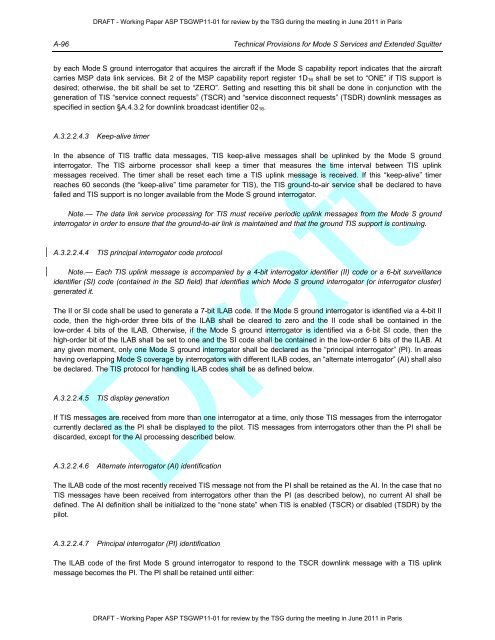Technical Provisions for Mode S Services and Extended Squitter
Technical Provisions for Mode S Services and Extended Squitter
Technical Provisions for Mode S Services and Extended Squitter
You also want an ePaper? Increase the reach of your titles
YUMPU automatically turns print PDFs into web optimized ePapers that Google loves.
DRAFT - Working Paper ASP TSGWP11-01 <strong>for</strong> review by the TSG during the meeting in June 2011 in Paris<br />
A-96 <strong>Technical</strong> <strong>Provisions</strong> <strong>for</strong> <strong>Mode</strong> S <strong>Services</strong> <strong>and</strong> <strong>Extended</strong> <strong>Squitter</strong><br />
by each <strong>Mode</strong> S ground interrogator that acquires the aircraft if the <strong>Mode</strong> S capability report indicates that the aircraft<br />
carries MSP data link services. Bit 2 of the MSP capability report register 1D16 shall be set to “ONE” if TIS support is<br />
desired; otherwise, the bit shall be set to “ZERO”. Setting <strong>and</strong> resetting this bit shall be done in conjunction with the<br />
generation of TIS “service connect requests” (TSCR) <strong>and</strong> “service disconnect requests” (TSDR) downlink messages as<br />
specified in section §A.4.3.2 <strong>for</strong> downlink broadcast identifier 0216.<br />
A.3.2.2.4.3 Keep-alive timer<br />
In the absence of TIS traffic data messages, TIS keep-alive messages shall be uplinked by the <strong>Mode</strong> S ground<br />
interrogator. The TIS airborne processor shall keep a timer that measures the time interval between TIS uplink<br />
messages received. The timer shall be reset each time a TIS uplink message is received. If this “keep-alive” timer<br />
reaches 60 seconds (the “keep-alive” time parameter <strong>for</strong> TIS), the TIS ground-to-air service shall be declared to have<br />
failed <strong>and</strong> TIS support is no longer available from the <strong>Mode</strong> S ground interrogator.<br />
Note.— The data link service processing <strong>for</strong> TIS must receive periodic uplink messages from the <strong>Mode</strong> S ground<br />
interrogator in order to ensure that the ground-to-air link is maintained <strong>and</strong> that the ground TIS support is continuing.<br />
A.3.2.2.4.4 TIS principal interrogator code protocol<br />
Note.— Each TIS uplink message is accompanied by a 4-bit interrogator identifier (II) code or a 6-bit surveillance<br />
identifier (SI) code (contained in the SD field) that identifies which <strong>Mode</strong> S ground interrogator (or interrogator cluster)<br />
generated it.<br />
The II or SI code shall be used to generate a 7-bit ILAB code. If the <strong>Mode</strong> S ground interrogator is identified via a 4-bit II<br />
code, then the high-order three bits of the ILAB shall be cleared to zero <strong>and</strong> the II code shall be contained in the<br />
low-order 4 bits of the ILAB. Otherwise, if the <strong>Mode</strong> S ground interrogator is identified via a 6-bit SI code, then the<br />
high-order bit of the ILAB shall be set to one <strong>and</strong> the SI code shall be contained in the low-order 6 bits of the ILAB. At<br />
any given moment, only one <strong>Mode</strong> S ground interrogator shall be declared as the “principal interrogator” (PI). In areas<br />
having overlapping <strong>Mode</strong> S coverage by interrogators with different ILAB codes, an “alternate interrogator” (AI) shall also<br />
be declared. The TIS protocol <strong>for</strong> h<strong>and</strong>ling ILAB codes shall be as defined below.<br />
A.3.2.2.4.5 TIS display generation<br />
Draft<br />
If TIS messages are received from more than one interrogator at a time, only those TIS messages from the interrogator<br />
currently declared as the PI shall be displayed to the pilot. TIS messages from interrogators other than the PI shall be<br />
discarded, except <strong>for</strong> the AI processing described below.<br />
A.3.2.2.4.6 Alternate interrogator (AI) identification<br />
The ILAB code of the most recently received TIS message not from the PI shall be retained as the AI. In the case that no<br />
TIS messages have been received from interrogators other than the PI (as described below), no current AI shall be<br />
defined. The AI definition shall be initialized to the “none state” when TIS is enabled (TSCR) or disabled (TSDR) by the<br />
pilot.<br />
A.3.2.2.4.7 Principal interrogator (PI) identification<br />
The ILAB code of the first <strong>Mode</strong> S ground interrogator to respond to the TSCR downlink message with a TIS uplink<br />
message becomes the PI. The PI shall be retained until either:<br />
DRAFT - Working Paper ASP TSGWP11-01 <strong>for</strong> review by the TSG during the meeting in June 2011 in Paris
















